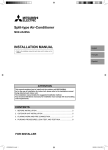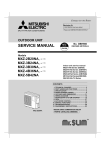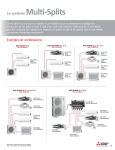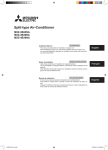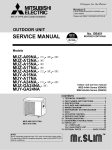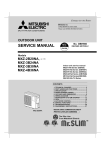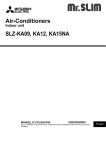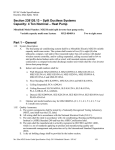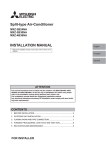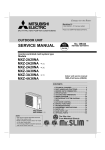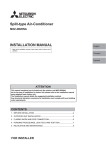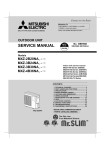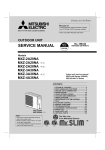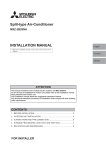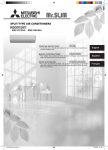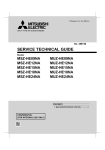Download MXZ-B•NA - Mitsubishi Electric
Transcript
Revision H: • MXZ-3B24NA - 1 , MXZ-3B30NA 4B36NA - 1 have been added. SPLIT-TYPE AIR CONDITIONERS 1 and MXZ- Please void OBT16 REVISED EDITION-G. No. OBT16 REVISED EDITION-H SERVICE TECHNICAL GUIDE Models MS-A•WA MSZ-A•NA MSY-A•NA MSZ-FD•NA MSZ-FE•NA MSZ-D•NA MSY-D•NA MSZ-GA•NA MSY-GA•NA MSZ-GE•NA MSY-GE•NA MFZ-KA•NA · MU-A•WA · MUZ-A•NA, · MUY-A•NA · MUZ-FD•NA, · MUZ-FE•NA · MUZ-D•NA, · MUY-D•NA · MUZ-GA•NA, · MUY-GA•NA · MUZ-GE•NA · MUY-GE•NA · MXZ-A•NA, - , · MXZ-B•NA, U U U U 1 2 1 CONTENTS 1. 2. 3. 4. CONFIDENTIAL (FOR INTERNAL USE ONLY) MS MICROPROCESSOR CONTROL ·················· 4 MSZ, MSY MICROPROCESSOR CONTROL ······7 MXZ MICROPROCESSOR CONTROL·············· 21 MFZ MICROPROCESSOR CONTROL ·············· 35 Revision A: • MXZ-3A30NA- 1 Revision B: • MXZ-2A20NA- 1 has been added. , MXZ-4A36NA, MSZ-FD, MSZ-D and MSY-D have been added. Revision C: • MXZ-2A20NA- 2 has been added. Revision D: • MSZ-GA•NA and MSY-GA•NA have been added. Revision E: • MSZ-FE•NA, MSZ-GE•NA, MSY-GE•NA and MXZ-B•NA have been added. Revision F: • MXZ-2B20NA- 1 , MXZ-3B24NA, MXZ-3B30NA, MXZ-4B36NA and MFZ-KA09/12/18NA have been added. Revision G: • MSZ-FE18NA, MSZ-GE24NA and MSY-GE24NA have been added. Revision H: • MXZ-3B24NA - 1 , MXZ-3B30NA - 1 and MXZ-4B36NA - have been added. 1 2 1. MS MICROPROCESSOR CONTROL ··················································································································· 4 Indoor unit models Outdoor unit models MS-A09/12WA MU-A09/12WA 1-1. COOL OPERATION ······································································································································· 4 1-2. DRY OPERATION ·········································································································································· 4 1-3. AUTO VANE OPERATION ····························································································································· 6 2. MSZ, MSY MICROPROCESSOR CONTROL ······································································································· 7 Indoor unit models Outdoor unit models MSZ-A09/12/15/17/24NA MSY-A15/17/24NA MSZ-FD09/12NA MSZ-FE09/12/18NA MSZ-D30/36NA MSY-D30/36NA MSZ-GA24NA MSY-GA24NA MSZ-GE06/09/12/15/18/24NA MSY-GE09/12/15/18/24NA MUZ-A09/12/15/17/24NA MUY-A15/17/24NA MUZ-FD09/12NA MUZ-FE09/12/18NA MUZ-D30/36NA MUY-D30/36NA MUZ-GA24NA MUY-GA24NA MUZ-GE09/12/15/18/24NA MUY-GE09/12/15/18/24NA 2-1. COOL OPERATION ······································································································································· 7 2-2. DRY OPERATION ·········································································································································· 8 2-3. HEAT OPERATION ········································································································································ 8 2-4. AUTO CHANGE OVER ··· AUTO MODE OPERATION··············································································· 10 2-5. OUTDOOR FAN MOTOR CONTROL ·········································································································· 11 2-6. AUTO VANE OPERATION ··························································································································· 11 2-7. INVERTER SYSTEM CONTROL ················································································································· 12 2-8. OPERATIONAL FREQUENCY CONTROL OF OUTDOOR UNIT ······························································ 17 2-9. EXPANSION VALVE CONTROL (LEV CONTROL) ···················································································· 18 2-10. PRE-HEAT CONTROL ································································································································· 20 3. MXZ MICROPROCESSOR CONTROL ··············································································································· 21 Outdoor unit models MXZ-2A20NA MXZ-4A36NA MXZ-2B20NA MXZ-3B30NA 3-1. 3-2. 3-3. 3-4. 3-5. 3-6. 3-7. 3-8. 3-9. 3-10. MXZ-3A30NA MXZ-3B24NA MXZ-4B36NA INVERTER SYSTEM CONTROL ················································································································· 21 EXPANSION VALVE CONTROL (LEV CONTROL) ···················································································· 23 OPERATIONAL FREQUENCY RANGE ······································································································ 29 HEAT DEFROSTING CONTROL ················································································································· 31 DISCHARGE TEMPERATURE PROTECTION CONTROL ··················································································31 OUTDOOR FAN CONTROL ························································································································ 32 PRE-HEAT CONTROL ································································································································· 33 COOL OPERATION ···············································································································································33 DRY OPERATION ··················································································································································34 HEAT OPERATION ······································································································································ 34 4. MFZ MICROPROCESSOR CONTROL ··············································································································· 35 Indoor unit models MFZ-KA09NA MFZ-KA12NA MFZ-KA18NA 4-1. COOL OPERATION ···································································································································· 35 4-2. DRY OPERATION ······································································································································· 35 4-3. HEAT OPERATION ····································································································································· 36 4-4. AUTO CHANGE OVER ··· AUTO MODE OPERATION ············································································· 37 4-5. INDOOR FAN MOTOR CONTROL ············································································································· 37 4-6. AUTO VANE OPERATION ·························································································································· 38 3 1 MS MICROPROCESSOR CONTROL 1-1. COOL ( ) OPERATION 1. Thermostat control Thermostat turns ON or OFF by the difference between room temperature and set temperature. Thermostat ON OFF Room temperature minus set temperature (Initial) Room temperature minus set temperature (During operation) -1.8°F(-1°C) or more less than -1.8°F(-1°C) -1.8°F (-1°C) -1.35°F (-0.75°C) 2. Indoor fan speed control Indoor fan operates continuously at the set speed by FAN SPEED CONTROL button regardless of the thermostat's OFFON. In AUTO the fan speed is as follows. Room temperature minus Room temperature minus Fan speed set temperature (Initial) set temperature (During operation) High 3.15°F(1.75°C) or more Med. between 1.8 and 3.15°F 5.4°F Low less than 1.8°F(1°C) (3°C) 1.8°F (1°C) 3.15°F (1.75°C) 3. Coil frost prevention Temperature control When the indoor coil thermistor RT12 reads 37°F (3°C) or below the coil frost prevention mode starts immediately. However, the coil frost prevention does not work for 5 minutes since the compressor has started. The indoor fan operates at the set speed and the compressor stops for 5 minutes. After that, if the indoor coil thermistor still reads below 37°F (3°C), this mode is prolonged until the indoor coil thermistor reads over 37°F (3°C). Time control When the 3 conditions as follows have been satisfied for 1 hour and 45 minutes, compressor stops for 3 minutes. a. Compressor has been continuously operating. b. Indoor fan speed is Low or Med. c. Room temperature is below 79°F (26°C). When compressor stops, the accumulated time is cancelled and when compressor restarts, time counting starts from the beginning. Time counting also stops temporarily when the indoor fan speed becomes High or the room temperature exceeds 79°F (26°C). However, when two of the above conditions (b. and c.) are satisfied again, time accumulation is resumed. Operation chart Example Compressor Outdoor fan Indoor fan OFF ON ( Continuously at set speed) ) OPERATION Set temperature is as shown on the right chart. The system for dry operation uses the same refrigerant circuit as the cooling circuit. The compressor and the indoor fan are controlled by the room temperature. By such controls, indoor flow amounts will be reduced in order to lower humidity without much room temperature decrease. 95(35) Set temperature [°F(°C)] 1-2. DRY ( ON Set temperature and initial room temperature in dry mode 86(30) 77(25) 68(20) 59(15) 50(10) 50 (10) 4 59 68 77 86 95 (15) (20) (25) (30) (35) Initial room temperature [°F(°C)] 1. Thermostat control Thermostat turns ON or OFF by the difference between room temperature and set temperature. Thermostat ON OFF Room temperature minus set temperature (Initial) Room temperature minus set temperature (During operation) -3.6°F(-2°C) or more less than -3.6°F(-2°C) -3.6°F (-2°C) -1.35°F (-0.75°C) 2. Indoor fan speed control Indoor fan operates at the set speed by FAN SPEED CONTROL button. When thermostat OFF (compressor OFF), fan speed becomes Very Low. In AUTO the fan speed is as follows. Fan speed High Med. Low Room temperature minus set temperature (Initial) 3.15°F(1.75°C) or more between 1.8 and 3.15°F less than 1.8°F(1°C) Room temperature minus set temperature (During operation) 1.8°F (1°C) 4.5°F (2.5°C) 3.15°F (1.75°C) 3. The operation of the compressor and indoor/outdoor fan Compressor operates by room temperature control and time control. Set temperature is controlled to fall 4°F (2°C) from initial room temperature. Indoor fan and outdoor fan operate in the same cycle as the compressor. • When the room temperature is 73°F (23°C) or over: • When The Thermostat is ON, the compressor repeats 8 minutes ON and 3 minutes OFF. • When The thermostat is OFF, the compressor repeats 4 minutes OFF and 1 minute ON. • When the room temperature is under 73°F (23°C). • When The Thermostat is ON, the compressor repeats 2 minutes ON and 3 minutes OFF. • When The thermostat is OFF, the compressor repeats 4 minutes OFF and 1 minute ON. Operation time chart Example Thermostat ON OFF Indoor fan ON OFF Outdoor fan Compressor ON OFF 8 minutes 3 minutes 4 minutes 1 minute 4. Coil frost prevention Coil frost prevention is as same as COOL mode. (2-1.3.) The indoor fan maintains the actual speed of the moment. However, when coil frost prevention works while the compressor is not operating, its speed becomes the set speed. 5 1-3. AUTO VANE OPERATION 1. Horizontal vane ECONO COOL ( ) operation (ECONOmical operation) When ECONO COOL button is pressed in COOL mode, set temperature is automatically set 3.6°F (2°C) higher than that in COOL mode. Also the horizontal vane swings in various cycle according to the temperature of indoor heat exchanger (indoor coil thermistor). SWING operation makes you feel cooler than set temperature. So, even though the set temperature is higher than that in COOL mode, the air conditioner can keep comfort. As a result, energy can be saved. To cancel this operation, select a different mode or press one of the following buttons in ECONO COOL operation: ECONO COOL or VANE CONTROL button. <SWING operation> In swing operation of ECONO COOL operation mode, the initial air flow direction is adjusted to “Horizontal”. According to the temperature of indoor coil thermistor at starting of this operation, next downward blow time is decided. Then when the downward blow has been finished, next horizontal blow time is decided. For initial 10 minutes the swing operation is performed in table G~H for quick cooling. Also, after 10 minutes when the difference of set temperature and room temperature is more than 3.6°F (2°C), the swing operation is performed in table D~H for more cooling. The air conditioner repeats the swing operation in various cycle as follows. A B C D E F G H Temperature of indoor coil thermistor (°F/°C) 59/15 or less 59/15 to 63 /17 63/17/ to 64/18 64/18 to 68/20 68/20 to 70/21 70/21 to 72/22 72/22 to 75/24 more than 75/24 Downward blow time Horizontal blow time (second) (second) 2 23 5 20 8 17 11 14 14 11 17 8 20 5 23 2 6 2 MSZ, MSY MICROPROCESSOR CONTROL 2-1. COOL ( ) OPERATION 1. Thermostat control Thermostat turns ON or OFF by the difference between room temperature and set temperature. Thermostat ON OFF Room temperature minus set temperature (Initial) Room temperature minus set temperature (During operation) -1.8°F(-1°C) or more less than -1.8°F(-1°C) -1.8°F (-1°C) -1.35°F (-0.75°C) 2. Indoor fan speed control Indoor fan operates continuously at the set speed by FAN SPEED CONTROL button regardless of the thermostat's OFFON. In AUTO the fan speed is as follows. Fan speed High Med. Low Room temperature minus set temperature (Initial) 3.15°F(1.75°C) or more between 1.8 and 3.15°F less than 1.8°F(1°C) Room temperature minus set temperature (During operation) 1.8°F (1°C) 3.15°F (1.75°C) 5.4°F (3°C) 3. Coil frost prevention The compressor operational frequency is controlled to prevent the temperature of indoor heat exchanger from falling excessively. The compressor is turned OFF for 5 minutes when the temperature of indoor coil thermistor continues 37°F (3°C) or less for 5 minutes or more. The indoor fan maintains the actual speed of the moment. 4. Low outside temperature operation If the outside temperature falls to 64°F (18°C) or less during operation in COOL mode, the unit will switch to the low outside temperature operation mode. <Operation> (1) Outdoor fan control The outdoor fan rotational speed slows down to maintain sufficient cooling capacity. NOTE: Even when the unit is in the "thermostat-off" status under the low outside temperature operation mode, the outdoor fan rotation does not stop. (2) Dew drop prevention When the ambient temperature thermistor reads 14°F (-10°C) or less (the set temperature is different depending on the models), as coil frost or dew drop from indoor unit may occur, the compressor turns OFF with the outdoor fan OFF for prevention of them. (3) Outdoor temperature detecting control To detect the exact outdoor temperature in this mode, the compressor turns OFF but the outdoor fan stays ON for 3 minutes once 1 hour. If the outdoor temperature rises over about 64°F (18°C), the unit goes back to the normal COOL mode. If the outside temperature stays below about 64°F (18°C), the unit continues to run in the low outside temperature operation mode. Other protections work as well as in the normal COOL mode. 7 ) OPERATION Set temperature is as shown on the right chart. The system for dry operation uses the same refrigerant circuit as the cooling circuit. The compressor and the indoor fan are controlled by the room temperature. By such controls, indoor flow amounts will be reduced in order to lower humidity without much room temperature decrease. 1. Thermostat control Thermostat turns ON or OFF by the difference between room temperature and set temperature. Thermostat ON OFF 95(35) Set temperature [°F(°C)] 2-2. DRY ( Set temperature and initial room temperature in dry mode 86(30) 77(25) 68(20) 59(15) 50(10) 50 (10) Room temperature minus set temperature (Initial) 59 68 77 86 95 (15) (20) (25) (30) (35) Initial room temperature [°F(°C)] Room temperature minus set temperature (During operation) -3.6°F(-2°C) or more less than -3.6°F(-2°C) -3.6°F (-2°C) 2. Indoor fan speed control Indoor fan operates at the set speed by FAN SPEED CONTROL button. When the thermostat turns OFF (compressor OFF), fan speed becomes Very Low. In AUTO the fan speed is as follows. Fan speed High Med. Low Room temperature minus set temperature (Initial) 3.15°F(1.75°C) or more between 1.8 and 3.15°F less than 1.8°F(1°C) -1.35°F (-0.75°C) Room temperature minus set temperature (During operation) 1.8°F (1°C) 4.5°F (2.5°C) 3.15°F (1.75°C) 3. Coil frost prevention Coil frost prevention is as same as COOL mode. (2-1.3.) The indoor fan maintains the actual speed of the moment. However, when coil frost prevention works while the compressor is not operating, its speed becomes the set speed. 4. Low outside temperature operation Low outside temperature operation is as same as COOL mode. (2-1.4.) 2-3. HEAT ( ) OPERATION (MSZ) 1. Thermostat control Thermostat turns ON or OFF by difference between room temperature and set temperature. (MSZ-FE18 MSZ-GE24) Thermostat ON OFF (Other models) Thermostat ON OFF Room temperature minus set temperature (Initial) less than 1.8°F(1°C) 1.8°F(1°C) or more Room temperature minus set temperature (Initial) less than 3.6°F(2°C) 3.6°F(2°C) or more 2. Indoor fan speed control (1) Indoor fan operates at the set speed by FAN SPEED CONTROL button. In Auto the fan speed is as follows. Set temperature minus Fan speed room temperature (Initial) High Med. Low 3.6°F(2°C) or more Between 0.45 and 3.6°F Less than 0.45°F(0.25°C) 8 Room temperature minus set temperature (During operation) 1.35°F 1.8°F (0.75°C) (1°C) Room temperature minus set temperature (During operation) 3.15°F 3.6°F (1.75°C) (2°C) Set temperature minus room temperature (During operation) 3.6°F (2°C) 0.45°F 3.15°F (0.25°C) (1.75°C) 7.2°F (4°C) (2) Cold air prevention control MSZ-A09/12/15/17 MSZ-FD MSZ-FE MSZ-D MSZ-GE When the compressor is not operating, ( ) if the temperature of room temperature thermistor is less than 66°F (19°C), the fan stops. ( ) if the temperature of room temperature thermistor is 66°F (19°C) or more and ( ) if the temperature of indoor coil thermistor is less than 32°F (0°C), the fan stops. ( ) if the temperature of indoor coil thermistor is 32°F (0°C) or more, the fan operates at Very Low. When the compressor is operating, ( ) if the temperature of indoor coil thermistor is 104°F (40°C) or more, the fan operates at set speed. ( ) if the temperature of indoor coil thermistor is less than 104°F (40°C) and ( ) if heating operation starts after defrosting, the fan stops. ( ) if the temperature of room temperature thermistor is 66°F (19°C) or less, the fan stops. ( ) if the temperature of room temperature thermistor is more than 66°F (19°C), the fan operates at Very Low. NOTE: When 4 minutes (MSZ-FE18 MSZ-GE24)/3 minutes (Other models) have passed since the compressor started operation, this control is released regardless of the temperature of room temperature thermistor and indoor coil thermistor. MSZ-A24 MSZ-GA When the compressor is not operating, ( ) if the temperature of room temperature thermistor is 59°F (15°C) or less, or temperature of indoor coil thermistor is less than 64°F (18°C), the fan stops. ( ) if the temperature of room temperature thermistor is more than 59°F (15°C), or temperature of indoor coil thermistor is more than 64°F (18°C), the fan operates at Very Low. When the compressor is operating, ( ) if the temperature of indoor coil thermistor is 64°F (18°C) or more, the fan operates at set speed. ( ) if the temperature of indoor coil thermistor is less than 64°F (18°C) and ( ) if heating operation starts after defrosting, the fan stops. ( ) if the temperature of room temperature thermistor is 59°F (15°C) or less, the fan stops. ( ) if the temperature of room temperature thermistor is more than 59°F (15°C), the fan operates at Very Low. NOTE: When 3 minutes have passed since the compressor started operation, this control is released regardless of the temperature of room temperature thermistor and indoor coil thermistor. (3) Warm air control (MSZ-FD MSZ-FE MSZ-GE) When the following any condition of (a. ~ c.) and the condition of are satisfied at the same time, warm air control works. a.) Fan speed is used in MANUAL. b.) When cold air prevention has been released. c.) When defrosting has been finished. When the temperature of indoor coil thermistor is less than 104°F (40°C). When warm air control works, the fan speed changes as follows to blow out warm air gradually. Gradation of fan speed in initial <Indoor fan speed> (MSZ-FE18 MSZ-GE24) <Time condition> Less than 4 minutes------------ Low 4 to 8 minutes-------------------- Med. More than 8 minutes ----------- High (Other models) <Time condition> <Indoor fan speed> Less than 2 minutes------------ Low 2 to 4 minutes-------------------- Med. More than 4 minutes ----------- High or Super high The upper limit of the fan speed in MANUAL is the set speed. When the temperature of indoor coil thermistor has been 104°F (40°C) or more, or when the set speed has been changed, this control is released and the fan speed is the set speed. 3. Overload starting When the room temperature thermistor reads 64°F (18°C) or more, the compressor runs with its maximum frequency regulated for 10 minutes after the start-up. 4. Defrosting (1) Starting conditions of defrosting When the following conditions a) ~ c) are satisfied, the defrosting starts. a) The defrost thermistor reads about 30.2°F (-1°C) or less. b) The cumulative operation time of the compressor has reached any of the set values (defrost interval: 40-150 minutes). c) More than 5 minutes have passed since the start-up of the compressor. The defrost interval is decided by the previous defrosting time. The next defrost interval extends or shortens 0-20 minutes compared with the previous defrost interval. 9 (2) Releasing conditions of defrosting Defrosting is released when any one of the following conditions is satisfied: a) The defrost thermistor continues to read "Defrost finish temperature" for 30 seconds. Refer to "CHANGE IN DEFROST SETTING of SERVICE FUNCTIONS in OUTDOOR UNIT SERVICE MANUAL". b) Defrosting time has exceeded 10 minutes. c) Any other mode than HEAT mode is set during defrosting. Time chart of defrosting in HEAT mode (reverse type) <Indoor unit> Horizontal vane horizontal set position Indoor fan horizontal (temperature of indoor coil thermistor < 102 °F) (39°C) set speed Very Low (temperature of indoor coil thermistor > 64 °F) (18°C) OFF set position set speed 30 seconds <Outdoor unit> Maximum frequency Compressor normal OFF 40 30 seconds seconds OFF 40 seconds 5 seconds ON 30 seconds 5 seconds ON Outdoor fan OFF R.V. coil (21S4) ON (HEAT) ON (HEAT) OFF (COOL) 2-4. AUTO CHANGE OVER ··· AUTO MODE OPERATION (MSZ) Once desired temperature is set, unit operation is switched automatically between COOL and HEAT operation. 1. Mode selection (1) Initial mode At first indoor unit operates only indoor fan with outdoor unit OFF for 3 minutes to detect present room temperature. Following the conditions below, operation mode is selected. If the room temperature thermistor reads more than set temperature, COOL mode is selected. If the room temperature thermistor reads set temperature or less, HEAT mode is selected. 10 (2) Mode change In case of the following conditions, the operation mode is changed. COOL mode changes to HEAT mode when 15 minutes have passed with the room temperature 2 - 4°F (1 - 2°C) below the set temperature. HEAT mode changes to COOL mode when 15 minutes have passed with the room temperature 2 - 4°F (1 - 2°C) above the set temperature. In the other cases than the above conditions, the present operation mode is continued. NOTE1: Mode selection is performed when multi standby (refer to NOTE2) is released and the unit starts operation with ON-timer. ), NOTE2: When two or more indoor units are operating simultaneously, the indoor unit, which is operating in AUTO ( might not be able to change over the operating mode (COOL ↔ HEAT) and becomes the standby state. (3) Indoor fan control/ Vane control As the indoor fan speed and the horizontal vane position depend on the selected operation mode, when the operation mode changes over, they change to the exclusive ones. 2-5. OUTDOOR FAN MOTOR CONTROL Fan speed is switched according to the compressor frequency. Fan speed High Down Up Low Min. Compressor frequency Max. <Relation between compressor frequency and fan speed> Compressor frequency (Hz) Down Up MUZ-A MUY-A MUZ-FD MUZ-FE09/12 MUZ-GA MUY-GA MUZ-GE12/15/18 MUY-GE12/15/18 MUZ-D MUY-D MUZ-GE09 MUY-GE09 MUZ-FE18 MUZ-GE24 MUY-GE24 33 44 39 54 33 43 2-6. AUTO VANE OPERATION 1. Horizontal vane (1) Cold air prevention in HEAT operation (MUZ) When any of the following conditions occur in HEAT operation, the vane angle changes to Horizontal position automatically to prevent cold air blowing on users. Compressor is not operating. Defrosting is performed. Indoor coil thermistor temperature does not exceed 102°F (39°C) within about 3 minutes after compressor starts. NOTE: When 2 or more indoor units are operated with multi outdoor unit, even if any indoor unit turns thermostat OFF, this control does not work in the indoor unit. (2) ECONO COOL ( ) operation (ECONOmical operation) (Excluding MSZ-FD and MSZ-FE09/12) When ECONO COOL button is pressed in COOL mode, set temperature is automatically set 3.6°F (2°C) higher than that in COOL mode. Also the horizontal vane swings in various cycle according to the temperature of indoor heat exchanger (indoor coil thermistor). SWING operation makes you feel cooler than set temperature. So, even though the set temperature is higher than that in COOL mode, the air conditioner can keep comfort. As a result, energy can be saved. To cancel this operation, select a different mode or press one of the following buttons in ECONO COOL operation: ECONO COOL or VANE CONTROL button. 11 <SWING operation> In swing operation of ECONO COOL operation mode, the initial air flow direction is adjusted to “Horizontal”. According to the temperature of indoor coil thermistor RT12 at starting of this operation, next downward blow time is decided. Then when the downward blow has been finished, next horizontal blow time is decided. For initial 10 minutes the swing operation is performed in table G~H for quick cooling. Also, after 10 minutes when the difference of set temperature and room temperature is more than 3.6°F (2°C), the swing operation is performed in table D~H for more cooling. The air conditioner repeats the swing operation in various cycle as follows. Temperature of indoor coil thermistor (°F/°C) 59/15 or less 59/15 to 63/17 63/17 to 64/18 64/18 to 68/20 68/20 to 70/21 70/21 to 72/22 72/22 to 75/24 more than 75/24 A B C D E F G H Downward blow time Horizontal blow time (second) (second) 2 23 5 20 8 17 11 14 14 11 17 8 20 5 23 2 2-7. INVERTER SYSTEM CONTROL 2-7-1. Inverter main power supply circuit MUZ-A09/12/15/17 MUY-A15/17 MUZ-FD MUZ-FE09/12 MSZ-GE06/09/12/15/18 MUY-GE09/12/15/18 REACTOR POWER SUPPLY NOISE FILTER CIRCUIT RESISTOR DIODE MODULE1 + ~ ~ - + SMOOTHING CAPACITOR P V N RELAY CURRENT TRANSFORMER U U W INTELLIGENT POWER MODULE ~ + ~ DIODE MODULE2 V MS 3~ W COMPRESSOR SWITCHING POWER TRANSISTOR BOOSTER CHOPPER CIRCUIT Function of main parts NAME FUNCTION INTELLIGENT POWER MODULE It supplies 3-phase AC power to compressor. SMOOTHING CAPACITOR It stabilizes the DC voltage and supplies it to INTELLIGENT POWER MODULE. CURRENT TRANSFORMER It measures the current of the compressor motor. DIODE MODULE 1 It converts the AC voltage to DC voltage. RESISTOR It absorbs the rush current not to run into the main power supply circuit when the electricity turns ON. RELAY It keeps the RESISTOR, which restricts rush current, short-circuited while the compressor is operating. BOOSTER CHOPPER CIRCUIT DIODE MODULE 2 SWITCHING POWER TRANSISTOR It improves power factor. It controls the bus-bar voltage. REACTOR 12 MUZ-A24 MUY-A24 MUZ-D MUY-D MUZ-FE18 MUZ-GA MUY-GA MUZ-GE24 MUY-GE24 REACTOR POWER SUPPLY NOISE FILTER CIRCUIT RESISTOR + SMOOTHING CAPACITOR P V N RELAY POWER FACTOR CORRECTION MODULE CURRENT TRANSFORMER U U W INTELLIGENT POWER MODULE V MS 3~ W COMPRESSOR Function of main parts NAME FUNCTION INTELLIGENT POWER MODULE It supplies 3-phase AC power to compressor. SMOOTHING CAPACITOR It stabilizes the DC voltage and supplies it to INTELLIGENT POWER MODULE. CURRENT TRANSFORMER It measures the current of the compressor motor. REACTOR POWER FACTOR CORRECTION MODULE RESISTOR RELAY It rectifies AC, controls its voltage and improves the power factor of power supply. It absorbs the rush current not to run into the main power supply circuit when the electricity turns ON. It keeps the RESISTOR, which restricts rush current, short-circuited while the compressor is operating. 2-7-2. Outline of main power supply circuit MUZ-A09/12/15/17 MUY-A15/17 MUZ-FD MUZ-FE09/12 MUZ-GE09/12/15/18 MUY-GE09/12/15/18 1. At the start of operation Main power supply circuit is formed when RELAY is turned ON at COMPRESSOR startup. To prevent rush current from running into the circuit when power supply is turned ON, RESISTOR is placed in sub circuit. 2. At normal operation When AC runs into POWER P.C. board, its external noise is eliminated in NOISE FILTER CIRCUIT. After noise is eliminated from AC, it is rectified to DC by DIODE MODULE 1. DC voltage, to which AC has been rectified by process , is stabilized by SMOOTHING CAPACITOR and supplied to INTELLIGENT POWER MODULE. DC voltage, which has been stabilized in process , is converted to 3-phase AC by INTELLIGENT POWER MODULE and supplied to COMPRESSOR. CURRENT TRANSFORMER, which is placed in the power supply circuit to COMPRESSOR, is used to measure the value of phase current and locate the polar direction of rotor with algorithm. PWM (Pulse width modulation) controls impressed voltage and frequency with those pieces of information. 13 3. Purpose of PAM adoption PAM (Pulse Amplitude Modulation) has been adopted for the efficiency improvement and the adaptation to IEC harmonic current emission standard Outline of simple partial switching method In conventional inverter models, DIODE MODULE rectifies AC voltage to DC voltage, SMOOTHING CAPACITOR makes its DC waveform smooth, and INTELLIGENT POWER MODULE converts its DC voltage to imitated AC voltage again in order to drive the compressor motor. However, it has been difficult to meet IEC harmonic current emission standard by above circuit because harmonic gets generated in the input current waveform and power factor gets down. The simple partial switching method with PAM, which has been adopted this time, places and utilizes BOOSTER CHOPPER CIRCUIT before rectifying AC voltage in the general passive-method converter circuit. As harmonic gets suppressed and the peak of waveform gets lower by adding BOOSTER CHOPPER CIRCUIT as mentioned above and by synchronizing the timing of switching with the zero-cross point of waveform, the input current waveform can be improved and the requirement of IEC harmonic current emission standard can be satisfied. Since the switching synchronized with the zero cross point, this simple partial switching method has the feature of lower energy loss compared to active filter method. In addition, output and efficiency is enhanced by combining with vector-controlled inverter in order to boost the voltage of power supplied to INTELLIGENT POWER MODULE. Input current waveform without PAM Input current waveform with PAM Due to the time of no electricity; • Power factor gets worse. • Harmonic gets increased. Input voltage Input current Owing to the increase of energized time; • Power factor gets better. • Harmonic gets suppressed. Release of energy stored in L. Peak gets down. Energized time is extended by optimization of L inductance. Energized time is short in case L inductance is small. No electricity runs into diode module because the voltage at both sides of smoothing capacitor is higher than input voltage. Compulsory energizing by switching. 14 4. Intelligent power module INTELLIGENT POWER MODULE consists of the following components · IGBT (x6): Converts DC waveform to 3-phase AC waveform and outputs it. · Drive Circuit: Drives transistors. · Protection circuit: Protects transistors from overcurrent. Since the above components are all integrated in INTELLIGENT POWER MODULE, INTELLIGENT POWER MODULE has a merit to make the control circuit simplify and miniaturize. 5. Elimination of electrical noise NOISE FILTER CIRCUIT, which is formed by *CMC COILS and capacitors placed on the POWER P.C. board, eliminates electrical noise of AC power that is supplied to main power supply circuit. This circuit also prevents the electrical noise generated in the inverter circuit from leaking out. *CMC COILS: Common mode choke coils MUZ-A24 MUY-A24 MUZ-D MUY-D MUZ-FE18 MUZ-GA MUY-GA MUZ-GE24 MUY-GE24 1. At the start of operation Main power supply circuit is formed when RELAY is turned ON at COMPRESSOR startup. To prevent rush current from running into the circuit when power supply is turned ON, RESISTOR is placed in sub circuit. 2. At normal operation When AC runs into noise filter P.C. board, its external noise is eliminated in NOISE FILTER CIRCUIT. After noise is eliminated from AC, it is rectified to DC by REACTOR and POWER FACTOR CORRECTION MODULE. If the operating frequency becomes 25 Hz or more, DC voltage rises to 370 V. DC voltage, to which has AC been rectified by process , is stabilized by SMOOTHING CAPACITOR and supplied to INTELLIGENT POWER MODULE. The DC (Bus voltage), which has been stabilized in process , is converted to 3-phase AC by INTELLIGENT POWER MODULE and supplied to COMPRESSOR. CURRENT TRANSFORMER, which is placed in the power supply circuit to COMPRESSOR, is used to measure the value of phase current and locate the polar direction of rotor with algorithm. PWM (Pulse width modulation) controls impressed voltage and frequency with those pieces of information. 3. Power factor improvement Booster coil reactor and POWER FACTOR CORRECTION MODULE rectify AC to DC and control its voltage. In the motor drive system of sine wave control, power factor can be improved by reducing harmonics. POWER FACTOR CORRECTION MODULE and reactor stabilize the voltage of DC supplied to inverter circuit and make its waveform smooth. 4. Intelligent power module INTELLIGENT POWER MODULE consists of the following components. · IGBT (x6): Converts DC waveform to 3-phase AC waveform and outputs it. · Drive Circuit: Drives transistors. · Protection circuit: Protects transistors from over current. Since the above components are all integrated in INTELLIGENT POWER MODULE, INTELLIGENT POWER MODULE has a merit to make the control circuit simplified and miniaturized. 5. Elimination of electrical noise NOISE FILTER CIRCUIT, which is formed by *CMC COILS, *NMC COILS and capacitors placed on the POWER P.C. board, eliminates electrical noise of AC power that is supplied to main power supply circuit. This circuit also prevents the electrical noise generated in the inverter circuit from leaking out. *CMC COILS: Common mode choke coils *NMC COILS: Normal mode choke coils 15 2-7-3. Sine wave control In these air conditioners, compressor equips brushless DC motor which does not have Hall element. In short, the motor is sensorless. However, it is necessary to locate the polar direction of rotor in order to drive brushless DC motor efficiently. The general detection method of the polar direction for such a DC motor is to locate it from the voltage induced by unenergized stator. Therefore, it is necessary to have a certain period of time in which the stator is being unenergized for the rotor position detection when the voltage of supplied power is impressed. So the motor has been driven by square wave control (the conventional motor drive system) which energizes the motor only when the range of electrical angle is within 120° because it is forced to be unenergized within 30° at start & end of one heap in one waveform cycle (180°) when the voltage is impressed. However, torque pulsation occurs at rotation in this method when the current-carrying phases are switched over to other phases in sequence. Therefore, sine wave control system is adopted for these air conditioners because it can make the phase-to-phase current waveform smoother (sine wave) in order to drive the motor more efficiently and smoothly. 2-7-4. Characteristics of sine wave control in case of brushless DC motor ● Although ordinary 3-phase induction motor requires energy to excite the magnetic field of rotor, brushless DC motor does not need it. So, higher efficiency and torque are provided. ● This control provides the most efficient waveform corresponding to the rotational speed of compressor motor. ● The rotation can be set to higher compared to the conventional motor drive system. So, the time in which air conditioner can be operated with less energy is longer than conventional models. This can save annual electric consumption. ● Compared to square wave control, the torque pulsation is reduced at rotation so that the motor operates more quietly. ● Since the response and efficiency of motor are enhanced in sine wave control, finer adjustment can be provided. DC Motor AC Motor Rotor Permanent magnet is embedded. Excited by magnetic field of stator Rotor Position Signal Necessary Unnecessary In brushless DC motor, permanent magnet is embedded in the rotor. Therefore, it does not require energy to excite the rotor like AC motor does. However, it is necessary to control the frequency of 3-phase AC current supplied to the stator according to the polar direction of magnet embedded in the rotor so as to drive the motor efficiently. Controlling 3-phase AC current frequency also means controlling the timing to switch the polarity of stator. Therefore, the polar direction of rotor needs to be detected. 2-7-5. Control Method of Rotational speed Sine wave control makes the current transformers conduct real time detection of the value of the current running into the motor, locates the rotor position from the detected value, and decides if voltage should be impressed and if frequency should be changed. Compared to the conventional control and rotor position detection method, sine wave control can provide finer adjustment of the voltage of supplied power. The value of the current running into the motor is determined by each motor characteristic. 16 2-8. OPERATIONAL FREQUENCY CONTROL OF OUTDOOR UNIT 1. Outline The operational frequency is as following: First, the target operational frequency is set based on the difference between the room temperature and the set temperature. Second, the target operational frequency is regulated by discharge temperature protection, high pressure protection, electric current protection and overload protection and also by the maximum/minimum frequency. 2. Maximum/minimum frequency in each operation mode. Applied model MUZ-A09 MUZ-A12 MUZ-A15 MUY-A15 MUZ-A17 MUY-A17 MUZ-A24 MUY-A24 MUZ-FD09 MUZ-FD12 MUZ-FE09 MUZ-FE12 MUZ-FE18 MUZ-D30 MUZ-D36 MUY-D30 MUY-D36 MUZ-GA24 MUY-GA24 MUZ-GE09 MUY-GE09 MUZ-GE12 MUY-GE12 MUZ-GE15 MUY-GE15 MUZ-GE18 MUY-GE18 MUZ-GE24 MUY-GE24 Operational frequency (Hz) COOL HEAT (MUZ) DRY Minimum Maximum Minimum Maximum Minimum Maximum 32 70 32 76 32 57 32 73 32 71 32 57 10 82 15 93 10 68 10 87 15 93 10 68 15 110 15 108 15 102 10 52 10 100 10 41 10 62 10 100 10 41 10 52 10 100 10 41 10 62 10 100 10 41 26 120 26 124 26 120 20 84 20 87 20 83 20 91 20 94 20 83 20 79 — — 20 79 20 92 — — 20 79 15 101 15 108 15 101 28 93 30 105 28 48 20 98 30 98 30 55 15 90 15 102 15 54 15 98 15 108 15 83 26 120 26 124 26 120 The operation frequency in COOL mode is restricted by the upper limit frequency after 1 hour or 0.5 ~ 1 hour as shown below for dew prevention. It is rated frequency or less. Maximum frequency Upper limit frequency 1 hour or 0.5~1 hour Rated frequency or less Time 17 2-9. EXPANSION VALVE CONTROL (LEV CONTROL) Minimum: 33 pulses (MUZ-A09/12/15/17 MUY-A15/17) 59 pulses (MUZ-A24 MUY-A24 MUZ-GA MUY-GA) 54 pulses (MUZ-FD MUZ-FE MUZ-GE MUY-GE) Control range 58 pulses (MUZ-D MUY-D) Maximum: 500 pulses Open: 40 pulses/second Actuating speed Close: 90 pulses/second Opening degree adjustment LEV opening degree is always adjusted in opening direction. (When reducing the opening degree, LEV is once over-closed, and then adjusted to the proper degree by opening. Unit OFF LEV remains at maximum opening degree (reaches maximum opening degree approximate in 15 minutes after compressor stops) Remote controller ON LEV is positioned. (First full-closed at zero pulses and then positioned.) During 1 to 15 minutes after compressor LEV is fixed to standard opening degree according to operational frequenstarts cy of compressor. More than about 15 minutes have passed LEV opening degree is corrected to get target discharge temperature of since compressor start-up compressor. (For lower discharge temperature than target temperature, LEV is corrected in closing direction.) (For higher discharge temperature than target temperature, LEV is corrected in opening direction.) It may take more than 30 minutes to reach target temperature, depending on operating conditions. Thermostat OFF LEV is adjusted to exclusive opening degree for thermostat OFF. Thermostat ON LEV is controlled in the same way as that after the compressor has started up. Defrosting in HEAT mode LEV is adjusted to open 500 pulses (2) Time chart Air conditioner OFF (thermostat off) Air conditioner ON LEV opening degree Positioning Standard opening degree Opening degree is corrected according to discharge temperature. (Refer to (3)) About 15 minutes Operational frequency of the compressor General operation Standard specification (1) Outline of LEV control The LEV basic control is comprised of setting LEV opening degree to the standard opening degrees set for each operational frequency of the compressor. However, when any change in indoor/outdoor temperatures or other factors cause air conditioning load fluctuation, the LEV control also works to correct LEV opening degree based on discharge temperature (Shell temperature) of the compressor, developing the unit's performance. Commanded to open Time ON OFF Time 18 Target discharge temperature (3) Control data F E D C B A 23 30 38 50 53 70 69 90 84 110 99 (Hz) (MUZ-FE18 MUZ-GE24 MUY-GE24) 130 (Hz) (Other models) Operational frequency of the compressor (a) Reference value of target discharge temperature COOL / HEAT (MUZ) °F/°C Applied model MUZ-A09/12 MUZ-A15/17 MUY-A15/17 MUZ-A24 MUY-A24 MUZ-GA MUY-GA MUZ-FD MUZ-FE09/12 MUZ-FE18 MUZ-GE24 MUY-GE24 MUZ-D MUY-D MUZ-GE09 MUY-GE09 MUZ-GE12 MUY-GE12 MUZ-GE15 MUY-GE15 MUZ-GE18 MUY-GE18 COOL HEAT COOL HEAT COOL HEAT COOL HEAT COOL HEAT COOL HEAT COOL HEAT COOL HEAT COOL HEAT COOL HEAT A 122/50 113/45 129/54 120/49 140/60 140/60 120/49 109/43 131/55 115/46 126/52 131/55 126/52 109/43 127/53 109/43 120/49 109/43 135/57 140/60 B 127/53 126/52 136/58 136/58 140/60 145/63 131/55 124/51 142/61 133/56 135/57 140/60 136/58 122/50 140/60 124/51 131/55 124/51 140/60 149/65 C 140/60 138/59 147/64 151/66 140/60 149/65 142/61 138/59 151/66 151/66 149/65 149/65 149/65 131/55 147/64 138/59 147/64 138/59 144/62 158/70 D 151/66 154/68 158/70 165/74 145/63 153/67 153/67 156/69 162/72 167/75 167/75 154/68 153/67 138/59 153/67 156/69 153/67 156/69 153/67 167/75 E 158/70 169/76 158/70 180/82 147/64 158/70 162/72 167/75 171/77 181/83 183/84 162/72 158/70 149/65 162/72 167/75 162/72 167/75 165/74 167/75 F 158/70 169/76 158/70 185/85 153/67 158/70 169/76 176/80 178/81 187/86 187/86 167/75 160/71 156/69 169/76 176/80 169/76 176/80 178/81 167/75 In COOL operation, the indoor coil thermistors (main and sub) sense temperature ununiformity (super heat) at the heat exchanger, and when temperature difference develops, the indoor coil thermistors adjust LEV opening degree to get approximate 18°F (10°C) lower temperature than the target temperature in the table above, thus diminishing super heat. 19 2-10. PRE-HEAT CONTROL MUZ-FD MUZ-FE MUZ-GE 1. Outline Compressor is energized to improve the start-up of compressor at a low outside temperature even when compressor is stopped. 2. Pre-heat control Compressor ON OFF ON Pre-heat control OFF Outside temperature 68°F (20°C) 30 minutes 1 hour Pre-heat control ON condition (1) Compressor is not operating. (However, pre-heat control is still OFF for 30 minutes after compressor is stopped, regardless of the outside temperature.) (2) Outside temperature is 68°F (20°C) or below. Outside temperature is monitored hourly, and when outside temperature is 68°F (20°C) or below, pre-heat control is turned ON. When pre-heat control is turned ON, compressor is energized about 50 W (40-60 W). (Compressor and fan are not operated.) MUZ-D MUY-D 1. Outline The compressor is energized even while it is not operating. This is to generate heat at the winding to improve the compressor's start-up condition. Power ON OFF Compressor ON OFF Defrost thermistor 69.8°F (21°C) 30 minutes Pre-heat 30 minutes 30 minutes 30 minutes 30 minutes 15 15 30 minutes minutes 30minutes minutes 30minutes ON OFF Breaker ON Start operation Stop operation When the defrost thermistor reads 69.8°F(21°C) or more 2. Pre-heat control ON condition (1) Pre-heat control is turned ON for 15 or 30 minutes after the breaker is turned ON. (2) 30 min. after the unit is stopped, pre-heat control is turned ON for 15 or 30 minutes and turned OFF for 30 minutes. This is repeated as shown in the graph until the breaker is turned OFF. When the defrost thermistor reads less than 69.8°F (20°C), pre-heat control is ON for 30 minutes. When the defrost thermistor reads 69.8°F (21°C) or more, pre-heat control is ON for 15 minutes. NOTE: When the unit is started with the remote controller, pre-heat control is turned OFF. Compressor uses 50 W when preheat control is turned ON. 20 MXZ MICROPROCESSOR CONTROL 3 3-1. INVERTER SYSTEM CONTROL 3-1-1. Inverter main power supply circuit REACTOR POWER SUPPLY NOISE FILTER CIRCUIT RESISTOR + SMOOTHING CAPACITOR P V N RELAY POWER FACTOR CORRECTION MODULE CURRENT TRANSFORMER U U W INTELLIGENT POWER MODULE V MS 3~ W COMPRESSOR Function of main parts NAME FUNCTION INTELLIGENT POWER MODULE It supplies 3-phase AC power to compressor. SMOOTHING CAPACITOR It stabilizes the DC voltage and supplies it to INTELLIGENT POWER MODULE. CURRENT TRANSFORMER It measures the current of the compressor motor. REACTOR POWER FACTOR CORRECTION MODULE RESISTOR RELAY It rectifies AC, controls its voltage and improves the power factor of power supply. It absorbs the rush current not to run into the main power supply circuit when the power is turned ON. It keeps the RESISTOR, which restricts rush current, short-circuited while the compressor is operating. 3-1-2. Outline of main power supply circuit 1. At the start of operation Main power supply circuit is formed when RELAY is turned ON at COMPRESSOR startup. To prevent rush current from running into the circuit when power supply is turned ON, RESISTOR is placed in sub circuit. 2. At normal operation When AC runs into noise filter P.C. board, its external noise is eliminated in NOISE FILTER CIRCUIT. After noise is eliminated from AC, it is rectified to DC by REACTOR and POWER FACTOR CORRECTION MODULE. If the operating frequency becomes 25 Hz or more, DC voltage rises to 370 V. DC voltage, to which has AC been rectified by process , is stabilized by SMOOTHING CAPACITOR and supplied to INTELLIGENT POWER MODULE. The DC (Bus voltage), which has been stabilized in process , is converted to 3-phase AC by INTELLIGENT POWER MODULE and supplied to COMPRESSOR. CURRENT TRANSFORMER, which is placed in the power supply circuit to COMPRESSOR, is used to measure the value of phase current and locate the polar direction of rotor with algorithm. PWM (Pulse width modulation) controls impressed voltage and frequency with those pieces of information. 21 3. Power factor improvement Booster coil reactor and POWER FACTOR CORRECTION MODULE rectify AC to DC and control its voltage. In the motor drive system of sine wave control, power factor can be improved by reducing harmonics. POWER FACTOR CORRECTION MODULE and reactor stabilize the voltage of DC supplied to inverter circuit and make its waveform smooth. 4. Intelligent power module INTELLIGENT POWER MODULE consists of the following components. · IGBT (x6): Converts DC waveform to 3-phase AC waveform and outputs it. · Drive Circuit: Drives transistors. · Protection circuit: Protects transistors from over current. Since the above components are all integrated in INTELLIGENT POWER MODULE, INTELLIGENT POWER MODULE has a merit to make the control circuit simplified and miniaturized. 5. Elimination of electrical noise NOISE FILTER CIRCUIT, which is formed by *CMC COILS, *NMC COILS and capacitors placed on the P.C. board, eliminates electrical noise of AC power that is supplied to main power supply circuit. This circuit also prevents the electrical noise generated in the inverter circuit from leaking out. *CMC COILS: Common mode choke coils *NMC COILS: Normal mode choke coils 3-1-3. Sine wave control In these air conditioners, compressor equips brushless DC motor which does not have Hall element. In short, the motor is sensorless. However, it is necessary to locate the polar direction of rotor in order to drive brushless DC motor efficiently. The general detection method of the polar direction for such a DC motor is to locate it from the voltage induced by unenergized stator. Therefore, it is necessary to have a certain period of time in which the stator is being unenergized for the rotor position detection when the voltage of supplied power is impressed. So the motor has been driven by square wave control (the conventional motor drive system) which energizes the motor only when the range of electrical angle is within 120° because it is forced to be unenergized within 30° at start and end of one heap in one waveform cycle (180°) when the voltage is impressed. However, torque pulsation occurs at rotation in this method when the current-carrying phases are switched over to other phases in sequence. Therefore, sine wave control system is adopted for these air conditioners because it can make the phase-to-phase current waveform smoother (sine wave) in order to drive the motor more efficiently and smoothly. 3-1-4. Characteristics of sine wave control in case of brushless DC motor ● Although ordinary 3-phase induction motor requires energy to excite the magnetic field of rotor, brushless DC motor does not need it. So, higher efficiency and torque are provided. ● This control provides the most efficient waveform corresponding to the rotational speed of compressor motor. ● The rotation can be set to higher compared to the conventional motor drive system. So, the time in which air conditioner can be operated with less energy is longer than conventional models. This can save annual electric consumption. ● Compared to square wave control, the torque pulsation is reduced at rotation so that the motor operates more quietly. ● Since the response and efficiency of motor are enhanced in sine wave control, finer adjustment can be provided. DC Motor AC Motor Rotor Permanent magnet is embedded. Excited by magnetic field of stator Rotor Position Signal Necessary Unnecessary In brushless DC motor, permanent magnet is embedded in the rotor. Therefore, it does not require energy to excite the rotor like AC motor does. However, it is necessary to control the frequency of 3-phase AC current supplied to the stator according to the polar direction of magnet embedded in the rotor so as to drive the motor efficiently. Controlling 3-phase AC current frequency also means controlling the timing to switch the polarity of stator. Therefore, the polar direction of rotor needs to be detected. 3-1-5. Control Method of Rotational speed Sine wave control makes the current transformers conduct real time detection of the value of the current running into the motor, locates the rotor position from the detected value and decides if voltage should be impressed and if frequency should be changed. Compared to the conventional control and rotor position detection method, sine wave control can provide finer adjustment of the voltage of supplied power. The value of the current running into the motor is determined by each motor characteristic. 22 3-2. EXPANSION VALVE CONTROL (LEV CONTROL) Linear expansion valve (LEV) is controlled by “Thermostat ON” commands given from each unit. Indoor unit status Stop of all indoor unit LEV opening Opening before stop → 500 pulses in 15 minutes When outdoor unit is operating, some indoor units stop and some operate. COOL: 5 pulses (full closed) HEAT: (MXZ-2A/3A30NA/2B): 140 pulses (slightly opened) : (MXZ-3A30NA- 1 /4A/3B/4B): 100 → 59 pulses Thermostat OFF in COOL or DRY mode When the outdoor unit operates (When the other indoor unit operates): 5 pulses When outdoor unit stops. (When the other indoor unit stops or thermo OFF): Maintain LEV opening before stop → 500 pulses in 15 minutes Thermostat ON in COOL or DRY mode • LEV opening for each indoor unit is determined by adding adjustment according to the number of operating unit and the capacity class to standard opening, based on the operation frequency: e.g.) Opening 130 pulses in standard opening 1 → Minimum 80 pulses/Maximum 205 pulses (Capacity code 4 at 1 unit operation) (Capacity code 1 at 3 units operation) • After starting operation, adjustment according to intake super heat, discharge temperature is included in standard opening. 1 NOTE: LEV opening in each frequency at DRY operation and COOL operation is the same. However, velocity and compressor operation frequency controls are different. See 3-3. OPERATIONAL FREQUENCY RANGE (As far as the indoor unit velocity control goes, refer to DRY operation in MICROPROCESSOR CONTROL in indoor unit.) Thermostat OFF in HEAT mode Thermostat ON in HEAT mode • When the outdoor unit operates. (When the other indoor unit operates): 140 pulses • When the outdoor unit stops. (When the other indoor unit stops or thermo OFF): Maintain LEV opening before stop → 500 pulses in 15 minutes “ • LEV opening for each indoor unit is determined by adding adjustment according to the number of operating unit and the capacity class to standard opening, based on the operation frequency: e.g.) Opening 120 pulses in standard opening 1 → Minimum 70 pulses/Maximum 165 pulses (Capacity code 4 at 1 unit operation) (Capacity code 1 at 3 units operation) • After starting operation, opening becomes the one that adjustment according to discharge temperature was added to basic opening. 1 “ 1 LEV opening when the outdoor unit is operating: Upper limit 500 pulses, Lower limit 53 pulses (MXZ-2A/3A30NA/2B)/59 pulses (MXZ-3A30NA- 1 /4A/3B/4B). 23 MXZ-2A20NA/3A30NA The table below shows the role of Exclusive LEV and Receiver LEV in each operation mode. Circulation Amount Capacity Distribution Control COOL HEAT Exclusive LEV Receiver LEV Exclusive LEV Receiver LEV ○ × × ○ Discharge Temperature Protection High Pressure Protection ○ ○ ○ ○ ○ ○ ○ ○ ○ × ○ × Indoor heat exchanger Evaporation Temperature Protection ○ ○ — — Outdoor heat exchanger Exclusive LEV Receiver Receiver LEV (MXZ-3A30NA) In COOL mode, the two indoor coil thermistors (one main and one sub) sense temperature ununiformity (super heat) at the heat exchanger, and when temperature difference develops, the indoor coil thermistors adjust LEV opening to diminish the super heat. This action is called Evaporation Temperature Protection. The opening pulse of the Receiver LEV is fixed to the standard No.3 in cooling operation, and so is that of each Exclusive LEV in heating operation. However the opening pulse will be changed to the standard No.4 or No.5 when the discharge temperature protection or highpressure protection is working. In addition to that, it will also be changed to standard No.2 or No.1 when the opening pulse of the each Exclusive LEV becomes 100 pulse or less in cooling operation or so does that of Receiver LEV in heating operation. <MXZ-2A20NA> LEV opening (pulse) Number of operating indoor units Standard No. COOL HEAT 1 unit 2 units 1 unit 2 units 200 300 400 450 500 150 320 360 410 500 120 140 160 220 280 120 140 160 220 280 1 2 3 4 5 <MXZ-3A30NA> Number of operating indoor units Standard No. 1 2 3 4 5 LEV opening (pulse) COOL HEAT 1 unit 2 units 3 units 1 unit 2 units 3 units 150 250 350 400 450 250 320 360 410 460 250 320 370 420 470 250 300 450 460 470 250 300 380 400 450 250 300 380 390 440 24 Determination of LEV standard opening in each indoor unit • The standard opening is on the straight line, which connects an each standard point in the section where divided into seven according to the operation frequency of compressor as shown in the figure below. (LEV opening is controlled in proportion to the operation frequency.) NOTE: Opening is adjusted at the standard opening according to the indoor unit conditions. However, inclination of standard opening in each point of opening does not change with the original curve. • Add opening provided in Difference in capacity in the table below to the standard opening from 1 to 8, when capacity of the indoor unit is excluding code 1. • Add opening provided in Difference in operation number in the table below to determined LEV opening for each indoor unit, when 2 or 3 indoor units are operated at the same time. NOTE: Even when the adjusted standard opening exceeds the driving range from 59 to 500 pulse, actual driving output opening is in a range from 59 to 500 pulses. LEV Opening (code) 4Hz 10 09 08 07 06 05 04 03 02 01 23 14 38 23 54 32 69 41 84 100 115 131 146 MXZ-2A/2B 50 59 68 77 86 MXZ-3A/4A Compressor operating frequency (Hz) MXZ-2A20NA Standard opening (pulse) LEV Opening (code) 1 2 3 4 5 6 7 8 9 10 COOL 120 130 136 146 156 160 170 180 190 200 HEAT 100 110 120 130 146 160 170 180 190 200 COOL HEAT Difference in capacity Difference in operation number Code3,4 Code5,6 Code7,8 Code9,10 Code11,12 Code13,14 Code15or above 2 3 6 9 12 15 25 35 -20 3 6 9 52 55 65 75 0 MXZ-3A30NA Standard opening (pulse) LEV Opening (code) 1 2 3 4 5 6 7 8 9 10 COOL 126 130 134 138 140 142 182 228 296 310 HEAT 140 146 150 170 180 200 224 244 272 280 COOL HEAT Difference in operation number Difference in capacity Code3,4 Code5,6 Code7,8 Code9,10 Code11,12 Code13,14 Code15or above 2 3 3 6 9 12 15 25 35 -20 -30 3 6 9 52 55 65 75 0 0 25 MXZ-2A20NAExclusive LEV 1 , 2 MXZ-2B20NA MXZ-2B20NA- 1 Standard opening (pulse) LEV Opening (code) 1 2 3 4 5 6 7 8 9 10 COOL 120 130 136 146 156 160 170 180 190 200 HEAT 248 248 258 266 274 280 286 292 300 306 Difference in operation number Difference in capacity Code3,4 Code5,6 Code7,8 Code9,10 Code11,12 Code13,14 Code15or above 2 3 6 9 12 15 25 35 -20 3 6 9 52 55 65 75 30 COOL HEAT Receiver LEV Standard opening (pulse) LEV Opening (code) 1 2 3 4 5 6 7 8 9 10 COOL 140 150 160 170 180 190 200 200 200 200 HEAT 80 84 90 110 120 130 140 150 160 170 Operation number COOL HEAT MXZ-3A30NA- 1 Difference in operation number 2 -20 30 MXZ-4A36NA MXZ-3B24NA MXZ-3B30NA MXZ-4B36NA Exclusive LEV Standard opening (pulse) LEV Opening (code) 1 2 3 4 5 6 7 8 9 10 COOL 126 130 134 138 150 160 170 180 190 200 HEAT 248 248 258 266 274 280 286 292 300 306 COOL HEAT Difference in capacity Code3,4 Code5,6 Code7,8 Code9,10 Code11,12 Code13,14 Code15or above 3 6 9 12 15 25 35 3 6 9 52 55 65 75 Receiver LEV Standard opening (pulse) LEV Opening (code) 1 2 3 4 5 6 7 8 9 10 COOL 270 280 290 300 310 320 330 340 350 360 HEAT 140 152 160 170 180 200 224 244 274 280 Operation number COOL HEAT Capacity code Indoor unit Difference in operation number 2 3 4(MXZ-4A/4B) 28 56 84 -45 -60 -60 3 06 4 09 7 12 9 15 10 17 12 24 26 Difference in operation number 2 3 4(MXZ-4A/4B) -20 -30 -30 -4 -8 -12 <Correction> Discharge temperature Each correction • (Each gas pipe temperature thermistor - Minimum gas pipe temperature thermistor) 1 COOL ● 2 DRY ● 2 HEAT ● ● — ● • (Main indoor coil thermistor - Sub indoor coil thermistor) 1 Perform this, when number of operation units is 2 units or more. (MXZ-2A20NA and MXZ-3A30NA only) 2 Correct the LEV opening by discharge temperature. (1) LEV opening correction by discharge temperature The target discharge temperature is determined according to frequency zone and number of operation unit of the compressor. MXZ-2A20NA Target discharge temperature (°F/°C) Operation frequency of compressor (Hz) 1 , 2 MXZ-2B20NA MXZ-2B20NA- 2 units 122/50 122/50 132.8/56 140/60 140/60 140/60 1 Target discharge temperature (°F/°C) Operation frequency of compressor (Hz) Minimum ~ 23 24 ~ 38 39 ~ 54 55 ~ 69 70 ~ 85 86 ~ Maximum HEAT Number of operating unit 2 units 1 unit 136.4/58 122/50 140/60 132.8/56 149/65 140/60 154.4/68 140/60 158/70 140/60 158/70 140/60 1 unit 95/35 104/40 120.2/49 136.4/58 149/65 158/70 Minimum ~ 23 24 ~ 38 39 ~ 54 55 ~ 69 70 ~ 85 86 ~ Maximum MXZ-2A20NA- COOL COOL HEAT Number of operating unit 2 units 1 unit 136.4/58 122/50 140/60 132.8/56 149/65 140/60 154.4/68 145.4/63 158/70 150.8/66 158/70 152.6/67 1 unit 95/35 104/40 120.2/49 136.4/58 149/65 158/70 2 units 122/50 122/50 132.8/56 140/60 140/60 140/60 MXZ-3A30NA Target discharge temperature (°F/°C) COOL Operation frequency of compressor (Hz) Minimum ~ 14 15 ~ 23 24 ~ 32 33 ~ 41 42 ~ 50 51 ~ 59 60 ~ 68 69 ~ 77 78 ~ 86 87 ~ Maximum 1 unit 95/35 104/40 120.2/49 136.4/58 149/65 154.4/68 158/70 167/75 167/75 167/75 2 units 131/55 131/55 136.4/58 140/60 149/65 154.4/68 158/70 163.4/73 167/75 176/80 HEAT Number of operating unit 3 units 1 unit 134.6/57 125.6/52 134.6/57 136.4/58 145.4/63 149/65 149/65 154.4/68 158/70 154.4/68 163.4/73 154.4/68 167/75 154.4/68 176/80 154.4/68 179.6/82 154.4/68 179.6/82 172.4/78 27 2 unit 143.6/62 150.8/66 165.2/74 172.4/78 172.4/78 172.4/78 172.4/78 172.4/78 172.4/78 172.4/78 3 units 122/50 131/55 140/60 152.6/67 161.6/72 168.8/76 168.8/76 168.8/76 168.8/76 168.8/76 MXZ-3A30NA- 1 MXZ-4A36NA MXZ-3B24NA MXZ-3B30NA MXZ-4B36NA Target discharge temperature (°F/°C) COOL Operation frequency of compressor (Hz) Minimum ~ 14 15 ~ 23 24 ~ 32 33 ~ 41 42 ~ 50 51 ~ 59 60 ~ 68 69 ~ 77 78 ~ 86 87 ~ Maximum 1 unit 2 units 3 units 95/35 107.6/42 120.2/49 136.4/58 149/65 154.4/68 158/70 167/75 167/75 167/75 131/55 131/55 136.4/58 140/60 149/65 154.4/68 158/70 163.4/73 167/75 176/80 134.6/57 134.6/57 145.4/63 149/65 158/70 163.4/73 167/75 176/80 179.6/82 179.6/82 HEAT Number of operating unit 4 units 1 unit 140/60 140/60 140/60 143.6/62 149/65 158/70 158/70 161.6/72 161.6/72 161.6/72 125.6/52 136.4/58 149/65 154.4/68 154.4/68 154.4/68 154.4/68 154.4/68 154.4/68 172.4/78 4 units 2 unit 3 units (MXZ-4A/4B) 143.6/62 150.8/66 165.2/74 172.4/78 172.4/78 172.4/78 172.4/78 172.4/78 172.4/78 172.4/78 122/50 131/55 140/60 152.6/67 161.6/72 168.8/76 168.8/76 168.8/76 168.8/76 168.8/76 122/50 122/50 122/50 122/50 131/55 140/60 140/60 140/60 140/60 140/60 (MXZ-4A/4B) Correct the LEV opening according to the difference between target discharge temperature and discharge temperature. MXZ-2A MXZ-2B Discharge temperature (°F/°C) More than Target discharge temperature+18/10 Target discharge temperature + 18/10 to Target discharge temperature + 9 /5 Target discharge temperature + 9/5 to Target discharge temperature + 3.6/2 Target discharge temperature + 3.6/2 to Target discharge temperature - 3.6/2 Target discharge temperature - 3.6/2 to Target discharge temperature - 9/5 Target discharge temperature - 9/5 to Target discharge temperature - 18/10 Target discharge temperature - 18/10 or less LEV opening correction (pulse) COOL HEAT 5 8 4 3 2 1 0 0 -1 -1 -3 -2 -4 -3 MXZ-3A MXZ-4A MXZ-3B MXZ-4B LEV opening correction (pulse) COOL HEAT 4 6 2 2 1 1 0 0 -1 -1 -3 -2 -8 -8 Discharge temperature (°F/°C) More than Target discharge temperature + 21.6/12 Target discharge temperature + 21.6/12 to Target discharge temperature + 9/5 Target discharge temperature + 9/5 to Target discharge temperature + 5.4/3 Target discharge temperature + 5.4/3 to Target discharge temperature - 5.4/3 Target discharge temperature - 5.4/3 to Target discharge temperature - 9/5 Target discharge temperature - 9/5 to Target discharge temperature - 21.6/12 Target discharge temperature - 21.6/12 or less (2) Separate correction (COOL,DRY) (Correction by the separate super heat) a) Correct the LEV separately by temperature difference between each gas pipe temperature and the minimum gas pipe temperature of all. Calculate each super heat of the unit from the expression below; (Super heat) = (Each gas pipe temperature) - (Minimum gas pipe temperature) Separate correction is performed according to each super heat in the table below. MXZ-3A30NA MXZ-2A20NA Superheat (°F/°C) More than 16.2/9 10.8/6 to 16.2/9 5.4/3 to 10.8/6 5.4/3 or less LEV opening correction (pulse) 3 2 1 0 Superheat (°F/°C) More than 16.2/9 10.8/6 to 16.2/9 5.4/3 to 10.8/6 5.4/3 or less 28 LEV opening correction (pulse) 12 8 4 0 b) Correct the LEV separately by temperature difference “ ∆RT” between main/sub indoor coil thermistor. ∆RT (°F/°C) 10.8/6 ∆RT 7.2/4 ∆RT < 10.8/6 ∆RT < 7.2/4 LEV opening correction (pulse) 2 1 1 In addition, decrease the target discharge temperature corresponding ∆RT. ∆ RT (°F/°C) 10.8/6 ∆RT 7.2/4 ∆RT< 10.8/6 ∆RT < 7.2/4 Temperature to be decreased (°F/°C) 18/10 9/5 9/5 3-3. OPERATIONAL FREQUENCY RANGE MXZ-2A20NA Number of operating unit 4 7 9,10 12 8 ~ 10 11 ~ 13 14 ~ 16 17 ~ 1 2 MXZ-2A20NA- 2 DRY (Hz) 25 30 75 75 52 52 52 100 Min. 48 48 48 48 58 58 58 58 HEAT (Hz) Max. Defrost 92 92 92 92 100 100 100 100 112 100 112 100 112 100 112 100 COOL (Hz) Min. Max. 20 65 20 85 20 93 20 93 30 93 30 93 30 93 30 93 DRY (Hz) Min. 48 48 48 48 58 58 58 58 HEAT (Hz) Max. Defrost 92 92 92 92 92 92 92 92 110 101 110 101 110 101 110 101 35 34 75 75 52 52 52 93 Min. 30 30 30 30 58 58 58 58 HEAT (Hz) Max. Defrost 92 92 92 92 92 92 92 92 112 100 112 100 112 100 112 100 2 Number of operating unit 2 Capacity code 4 7 9,10 12 8 ~ 10 11 ~ 13 14 ~ 16 17 ~ 1 1 COOL (Hz) Min. Max. 20 65 20 85 20 100 20 100 30 105 30 105 30 105 20 105 1 Number of operating unit MXZ-2A20NA- Capacity code Capacity code 4 7 9,10 12 8 ~ 10 11 ~ 13 14 ~ 16 17 ~ COOL (Hz) Min. Max. 20 65 20 85 20 93 20 93 40 93 40 93 40 93 40 93 DRY (Hz) 25 34 75 75 53 53 53 93 29 MXZ-2B20NA Number of operating unit Capacity code 3, 4 7 9, 10 12 2~7 8 ~ 10 11 ~ 13 14 ~ 16 17 ~ 1 2 MXZ-2B20NA- COOL (Hz) Min. Max. 20 65 20 85 20 93 20 93 30 93 30 93 30 93 30 93 30 93 DRY (Hz) 25 34 75 75 53 53 53 53 93 Min. 30 30 30 30 58 58 58 58 58 HEAT (Hz) Max. Defrost 92 92 92 92 92 92 92 92 112 100 112 100 112 100 112 100 112 100 Min. 30 30 30 30 58 58 58 58 58 HEAT (Hz) Max. Defrost 92 92 92 92 92 92 92 92 112 99 112 99 112 99 112 99 112 99 Min. 22 22 22 22 35 35 35 35 39 HEAT (Hz) Max. Defrost 48 48 48 48 62 58 90 58 70 58 90 58 94 58 94 58 94 58 Min. 20 20 20 20 20 20 20 20 20 20 20 HEAT (Hz) Max. Defrost 70 58 70 58 80 58 80 58 80 58 80 58 80 58 80 58 80 58 103 58 113 58 1 Number of operating unit Capacity code 3, 4 7 9, 10 12 5~7 8 ~ 10 11 ~ 13 14 ~ 16 17 ~ 1 2 COOL (Hz) Min. Max. 20 65 20 85 20 93 20 93 30 93 30 93 30 93 30 93 30 93 DRY (Hz) 30 30 38 62 58 58 58 58 58 MXZ-3A30NA Number of operating unit 4 7 9,10 12 8 ~ 10 11 ~ 13 14 ~ 16 17 ~ 12 ~ 1 2 3 MXZ-3A30NA- Capacity code 1 2 3 (MXZ-3A) 3 (MXZ-4A) 4 (MXZ-4A) DRY (Hz) 20 25 44 44 31 31 31 59 65 MXZ-4A36NA Number of operating unit 1 COOL (Hz) Min. Max. 15 58 15 58 15 62 15 68 24 80 24 80 24 80 24 80 52 90 Capacity code 4 7 9,10 12 8 ~ 10 11 ~ 13 14 ~ 16 17 ~ 12 ~ 12 ~ 16 ~ COOL (Hz) Min. Max. 25 58 25 58 25 71 25 80 25 80 25 80 25 80 25 80 25 80 25 90 25 90 DRY (Hz) 25 25 25 35 31 31 42 42 52 52 52 30 MXZ-3B24NA MXZ-3B30NA MXZ-4B36NA Number of operating unit 1 2 3 (MXZ- 3B) 3 (MXZ-4B) 4 (MXZ-4B) Capacity code 3,4 7 9,10 12 5~7 8 ~ 10 11 ~ 13 14 ~ 16 17 ~ 9~ 9~ 12 ~ COOL (Hz) Min. Max. 15 58 15 58 15 71 15 80 25 80 25 80 25 80 25 80 25 80 52 80 52 90 62 90 DRY (Hz) 22 22 31 42 35 35 35 35 52 52 52 70 Min. 25 25 25 25 35 35 35 35 35 39 39 52 HEAT (Hz) Max. Defrost 70 70 70 70 80 80 80 80 80 80 80 80 80 80 80 80 80 80 80 80 103 80 113 80 3-4. HEAT DEFROSTING CONTROL (1) Starting conditions of defrosting When the following conditions a) ~ c) are satisfied, the defrosting starts. a) The defrost thermistor reads 26.6°F (-3°C) or less. b) The cumulative operation time of the compressor has reached any of the set values (defrost interval: 40-150 minutes). c) More than 5 minutes have passed since the start-up of the compressor. The defrost interval is decided by the previous defrosting time. The next defrost interval extends or shortens 0-20 minutes compared with the previous defrost interval. (2) Releasing conditions of defrosting Defrosting is released when any one of the following conditions is satisfied: a) The defrost thermistor continues to read 50.7°F (10.4°C). b) Defrosting time exceeds 10 minutes. c) Any other mode than HEAT mode is set during defrosting. 3-5. DISCHARGE TEMPERATURE PROTECTION CONTROL This protection controls the compressor ON/OFF and operation frequency according to temperature of the discharge temperature thermistor. (1) Compressor ON/OFF When temperature of the discharge temperature thermistor exceeds 240.8°F (116°C), the control stops the compressor. When temperature of the discharge temperature thermistor is 176°F (80°C) (2A/3A30NA/2B)/ 212°F (100°C) (3A30NA1 /4A/3B/4B) or less, the controls starts the compressor. (2) Compressor operation frequency When temperature of the discharge temperature thermistor is expected to be higher than 240.8°F (116°C), the control decreases 12 Hz from the current frequency. When temperature of the discharge temperature thermistor is expected to be higher than 231.8°F (111°C) and less than 240.8°F (116°C), the control decreases 6 Hz from the current frequency. When temperature of the discharge temperature thermistor is expected to be higher than 219.2°F (104°C) and less than 231.8°F (111°C), the control is set at the current frequency. 31 3-6. OUTDOOR FAN CONTROL Fan speed is switched according to the number of operating indoor unit and the compressor frequency. MXZ-2B20NA <Relation between compressor frequency and fan speed> MXZ-2B20NA Compressor frequency (Hz) Down Up 30 40 Fan speed Down High Up Low Min. Compressor frequency Max. NOTE: When the indoor coil thermistor is 134.6 ˚F (57°C) or more on HEAT operation, fan speed is fixed to Low speed. Or, the indoor coil thermistor is 113 ˚F (45°C) or less on HEAT operation, fan speed is back to normal. MXZ-2B20NA- 1 MXZ-3B MXZ-4B COOL Fan speed changes so that the condensing temperature stays within the target range. Revolution per minutes (rpm) Fan speed 1 2 3 4 5 6 7 8 9 10 11 12 13 14 MXZ-2B20NA100 150 200 250 300 350 400 450 500 550 600 650 700 750 1 MXZ-3B MXZ-4B Frequency (Hz) Target condensing temperature (°F/°C) ~24 87.8/31-95.0/35 25~34 91.4/33-98.6/37 35~44 95.0/35-102.2/39 45~54 98.6/37-105.8/41 55~64 98.6/37-105.8/41 65~ 98.6/37-105.8/41 100 150 200 250 300 350 400 450 500 550 600 650 700 750 HEAT Fan speed is switched according to the compressor frequency. Fan speed Up Down Fan speed Compressor speed (Hz) MXZ-3B MXZ-2B20NA- 1 MXZ-4B 30 50 23 40 Down High Up Low Min. 32 Compressor frequency Max. 3-7. PRE-HEAT CONTROL MXZ-2A20NA- 1 , 2 MXZ-3A30NA- 1 MXZ-4A36NA MXZ-2B20NA MXZ-2B20NAMXZ-3B24NA MXZ-3B30NA MXZ-4B36NA 1 The compressor is energized even while it is not operating. This is to generate heat at the winding to improve the compressor's start-up condition. Power ON OFF Compressor ON OFF Defrost thermistor 69.8°F (21°C) 30 minutes Pre-heat 30 minutes 30 minutes 30 minutes 30 minutes 15 15 30 minutes minutes 30minutes minutes 30minutes ON OFF Breaker ON Start operation Stop operation When the defrost thermistor reads 69.8°F(21°C) or more 1. Pre-heat control is turned ON for 15 or 30 minutes, after the breaker is turned ON. 2. 30 minutes after the unit is stopped, pre-heat control is turned ON for 15 or 30 minutes and turned OFF for 30 minutes. This is repeated as shown in the graph until the breaker is turned OFF. When the defrost thermistor reads less than 69.8°F (21°C), pre-heat control is ON for 30 minutes. When the defrost thermistor reads 69.8°F (21°C) or more, pre-heat control is ON for 15 minutes. NOTE: When the unit is started with the remote controller, pre-heat control is turned OFF. Compressor uses 50 W when pre-heat control is turned ON. 3-8. COOL OPERATION 1. Thermostat control Thermostat turns ON or OFF by the difference between room temperature and set temperature. Thermostat ON OFF Room temperature minus set temperature (Initial) -1.8°F(-1°C) or more less than -1.8°F(-1°C) Room temperature minus set temperature (During operation) -1.8°F (-1°C) -1.35°F (-0.75°C) 2. Coil frost prevention The compressor operational frequency is controlled to prevent the indoor heat exchanger temperature from falling excessively. Compressor is turned OFF for 5 minutes when temperature of indoor coil thermistor continues 37.4°F (3°C) or less for 5 minutes or more. 33 3-9. DRY OPERATION 1. Thermostat control Thermostat turns ON or OFF by the difference between room temperature and set temperature. Thermostat ON OFF Room temperature minus set temperature (Initial) Room temperature minus set temperature (During operation) -3.6°F(-2°C) or more less than -3.6°F(-2°C) -3.6°F (-2°C) -1.35°F (-0.75°C) 2. Coil frost prevention Coil frost prevention is as same as COOL mode. (3-8.2.) 3-10. HEAT OPERATION 1. Thermostat control Thermostat turns ON or OFF by the difference between room temperature and set temperature. MXZ-2A/3A/4A Thermostat ON OFF MXZ-2B/3B/4B Thermostat ON OFF Room temperature minus set temperature (Initial) less than 3.6°F(2°C) 3.6°F(2°C) or more Room temperature minus set temperature (Initial) less than 3.6°F(2°C) 3.6°F(2°C) or more Room temperature minus set temperature (During operation) 3.15°F 3.6°F (1.75°C) (2°C) Room temperature minus set temperature (During operation) 1.35°F 1.8°F (0.75°C) (1°C) 2. High pressure protection In HEAT operation the indoor coil thermistor detects the temperature of the indoor heat exchanger. The compressor operational frequency is controlled to prevent the condensing pressure from increasing excessively. 34 4 MFZ MICROPROCESSOR CONTROL 4-1. COOL ( ) OPERATION 1. Thermostat control Refer to MXZ MICROPROCESSOR CONTROL, COOL OPERATION (3-8.1.). 2. Indoor fan speed control Indoor fan operates continuously at the set speed by FAN SPEED CONTROL button regardless of the thermostat's OFFON. In AUTO the fan speed is as follows. Fan speed High Med. Low Room temperature minus set temperature (Initial) 3.15°F(1.75°C) or more between 1.8 and 3.15°F less than 1.8°F(1°C) Room temperature minus set temperature (During operation) 1.8°F (1°C) 3.15°F (1.75°C) 5.4°F (3°C) 3. Coil frost prevention Refer to MXZ MICROPROCESSOR CONTROL, COOL OPERATION (3-8.2.). ) OPERATION The system for dry operation uses the same refrigerant circuit as the cooling circuit. The compressor and the indoor fan are controlled by the room temperature. By such controls, indoor flow amounts will be reduced in order to lower humidity without much room temperature decrease. Set temperature and °F initial room temperature in dry mode 95 86 Set temperature 4-2. DRY ( 77 68 59 50 50 59 68 77 86 Initial room temperature 95 °F 1. Thermostat control Refer to MXZ MICROPROCESSOR CONTROL, DRY OPERATION (3-9.1.). 2. Indoor fan speed control Indoor fan operates at the set speed by FAN SPEED CONTROL button. When thermostat OFF (compressor OFF) fan speed becomes Very Low. In AUTO the fan speed is as follows. Fan speed High Med. Low Room temperature minus set temperature (Initial) 3.15°F(1.75°C) or more between 1.8 and 3.15°F less than 1.8°F(1°C) 3. Coil frost prevention Coil frost prevention is as same as COOL mode. (4-1.3.) The indoor fan maintains the actual speed of the moment. 35 Room temperature minus set temperature (During operation) 1.8°F (1°C) 4.5°F (2.5°C) 3.15°F (1.75°C) 4-3. HEAT ( ) OPERATION 1. Thermostat control Refer to MXZ MICROPROCESSOR CONTROL, HEAT OPERATION (3-10.1.). 2. Indoor fan speed control (1) Indoor fan operates at the set speed by FAN SPEED CONTROL button. In Auto the fan speed is as follows. Fan speed Set temperature minus room temperature (Initial) High Med. Low 3.6°F(2°C) or more Between 0.45 and 3.6°F Less than 0.45°F(0.25°C) Set temperature minus room temperature (During operation) 3.6°F (2°C) 7.2°F (4°C) 0.45°F 3.15°F (0.25°C) (1.75°C) (2) Cold air prevention control When the compressor is not operating: ( ) If the temperature of room temperature thermistor RT11 is less than 66.2°F, the fan stops. ( ) If the temperature of room temperature thermistor RT11 is 66.2°F or more and ( ) if the temperature of indoor coil thermistor is less than 32°F, the fan stops. ( ) if the temperature of indoor coil thermistor is 32°F or more, the fan operates at Very Low. When the compressor is operating: ( ) If the temperature of indoor coil thermistor is 104°F or more, the fan operates at set speed. ( ) If the temperature of indoor coil thermistor is less than 104°F and ( ) if heating operation starts after defrosting, the fan stops. ( ) if the temperature of room temperature thermistor RT11 is 66.2°F or less, the fan stops. ( ) if the temperature of room temperature thermistor RT11 is more than 66.2°F, the fan operates at Very Low. NOTE: • When 2 or more indoor units are operated with a multi type outdoor unit, the fan operates intermittently at Very Low or stops in the thermostat-OFF units while at least one unit is thermostat-ON. • When 3 minutes have passed since the compressor started operation, this control is released regardless of the temperature of RT11 and indoor coil thermistor. 3. High pressure protection In HEAT operation, the indoor coil thermistor detects the temperature of the indoor heat exchanger. The compressor operational frequency is controlled to prevent the condensing pressure from increasing excessively. 4. Defrosting Refer to MXZ MICROPROCESSOR CONTROL, HEAT DEFROSTING CONTROL (3-4.). Time chart of defrosting in HEAT mode (reverse type) <Indoor unit> Horizontal vane Indoor fan (upper) Indoor fan (lower) vertical set position set speed ON set position Very Low (temperature of indoor coil thermistor > 64.4°F) OFF 30 seconds set speed ON OFF Damper OPEN or CLOSE CLOSE 36 OPEN or CLOSE 4-4. AUTO CHANGE OVER ··· AUTO MODE OPERATION Once desired temperature is set, unit operation is switched automatically between COOL and HEAT operation. 1. Mode selection (1) Initial mode At first, indoor unit operates only indoor fan with outdoor unit OFF for 3 minutes to detect present room temperature. Following the conditions below, operation mode is selected. If the room temperature thermistor RT11 reads more than set temperature, COOL mode is selected. If the room temperature thermistor RT11 reads set temperature or less, HEAT mode is selected. (2) Mode change In case of the following conditions, the operation mode is changed. COOL mode changes to HEAT mode when 15 minutes have passed with the room temperature 35.6°F below the set temperature. HEAT mode changes to COOL mode when 15 minutes have passed with the room temperature 35.6°F above the set temperature. In the other cases than the above conditions, the present operation mode is continued. NOTE1: Mode selection is performed when multi standby (refer to NOTE2) is released and the unit starts operation with ON-timer. NOTE2: When two or more indoor units are operating simultaneously, the indoor unit, which is operating in AUTO ( ), might not be able to change over the operating mode (COOL HEAT) and becomes the standby state. (3) Indoor fan control/ Vane control As the indoor fan speed and the horizontal vane position depend on the selected operation mode, when the operation mode changes over, they change to the exclusive ones. 4-5. INDOOR FAN MOTOR CONTROL (1) Rotational frequency feedback control The indoor fan motor is equipped with a rotational frequency sensor, and outputs signal to the microprocessor to feedback the rotational frequency. Comparing the current rotational frequency with the target rotational frequency (Super High, High, Med., Low), the microprocessor adjusts fan motor electric current to make the current rotational frequency close to the target rotational frequency. With this control, when the fan speed is switched, the rotational frequency changes smoothly. Rotational frequency Super High Super High High Med. Low time (2) Fan motor lock-up protection When the rotational frequency feedback signal has not output for 12 seconds, (or when the microprocessor cannot detect the signal for 12 seconds) energizing to the fan motor is stopped. Then the microprocessor retries detection 3 times every 30 seconds. If the microprocessor still cannot detect the signal, the fan motor is regarded locked-up. When the fan motor locks up, OPERATION INDICATOR lamp flashes ON and OFF to show the fan motor abnormality. 37 4-6. AUTO VANE OPERATION Horizontal vane (1) Cold air prevention in HEAT operation When any of the following conditions occurs in HEAT operation, the vane angle changes to Vertical position automatically to prevent cold air blowing on users. Compressor is not operating. Defrosting is performed. Indoor coil thermistor reads 75.2°F or below. Indoor coil thermistor temperature is raising from 75.2°F or below, but it does not exceed 102.2°F. Indoor coil thermistor temperature Horizontal vane Set position Released Cold Air Prevention 75.2°F (24°C) 102.2°F (39°C) Vertical Position NOTE: The horizontal vane automatically moves in certain intervals to determine its position, and then it returns to the set position. Indoor fan motor (Lower) in COOL OPERATION Difference between room temperature and set temperature during operation Damper OPEN CLOSE Difference between room temperature and set temperature during operation 35.6°F (2°C) 44.6°F (7°C) Indoor fan motor (Lower) in HEAT OPERATION Indoor coil thermistor temperature Damper OPEN CLOSE Indoor coil thermistor temperature 95°F (35°C) 104°F (40°C) • As for indoor fan motor (upper), refer to "Indoor fan speed control (2-1.2, 2-2.2, 2-3.2)" and "INDOOR FAN MOTOR CONTROL (2-5.)". <SWING operation> In swing operation of ECONO COOL operation mode, the initial airflow direction is adjusted to "Horizontal". According to the temperature of indoor coil thermistor at starting of this operation, next downward blow time is decided. Then when the downward blow has been finished, next horizontal blow time is decided. For initial 10 minutes the swing operation is performed in table G~H for quick cooling. Also, after 10 minutes when the difference of set temperature and room temperature is more than 35.6°F, the swing operation is performed in table D~H for more cooling. The air conditioner repeats the swing operation in various cycle as follows. Temperature of indoor coil thermistor (°F) 59 or less A Downward blow time (second) Horizontal blow time (second) 2 23 B 59 to 63 5 20 C 63 to 64 8 17 D 64 to 68 11 14 E 68 to 70 14 11 F 70 to 72 17 8 G 72 to 75 20 5 H More than 75 23 2 38 39 HEAD OFFICE: TOKYO BLDG.,2-7-3, MARUNOUCHI, CHIYODA-KU, TOKYO 100-8310, JAPAN © Copyright 2006 MITSUBISHI ELECTRIC CO.,LTD Distributed in Jan. 2011. No. OBT16 REVISED EDITION-H Distributed in Sep. 2010. No. OBT16 REVISED EDITION-G 6 Distributed in Mar. 2010. No. OBT16 REVISED EDITION-F 6 Distributed in Sep. 2009. No. OBT16 REVISED EDITION-E 5 Distributed in Mar. 2009. No. OBT16 REVISED EDITION-D 4 Distributed in Jul. 2008. No. OBT16 REVISED EDITION-C 6 Distributed in Feb. 2008. No. OBT16 REVISED EDITION-B 6 Distributed in May 2007. No. OBT16 REVISED EDITION-A 7 Distributed in Apr. 2006. No. OBT16 7 Made in Japan New publication, effective Jan. 2011 Specifications subject to change without notice.









































